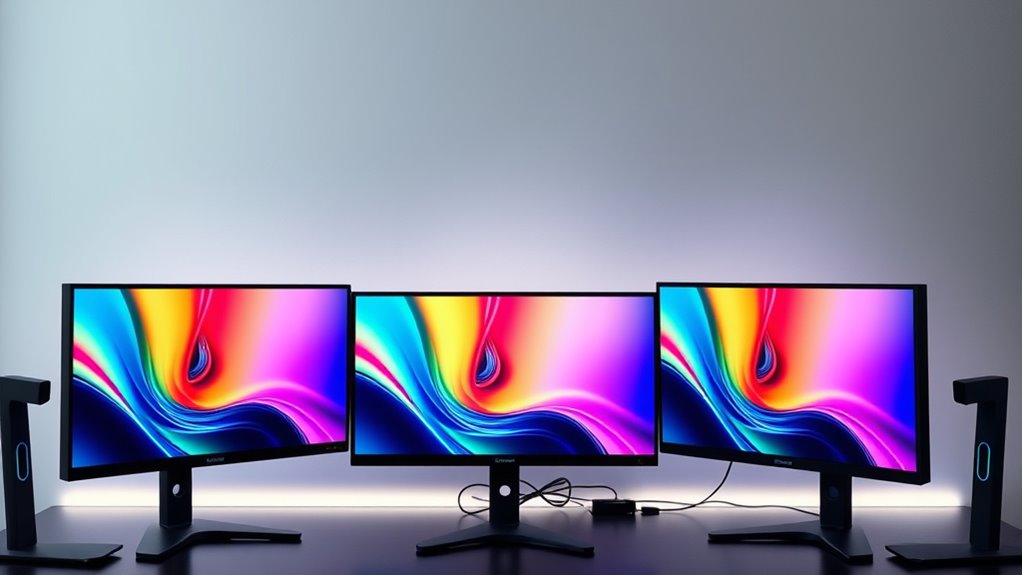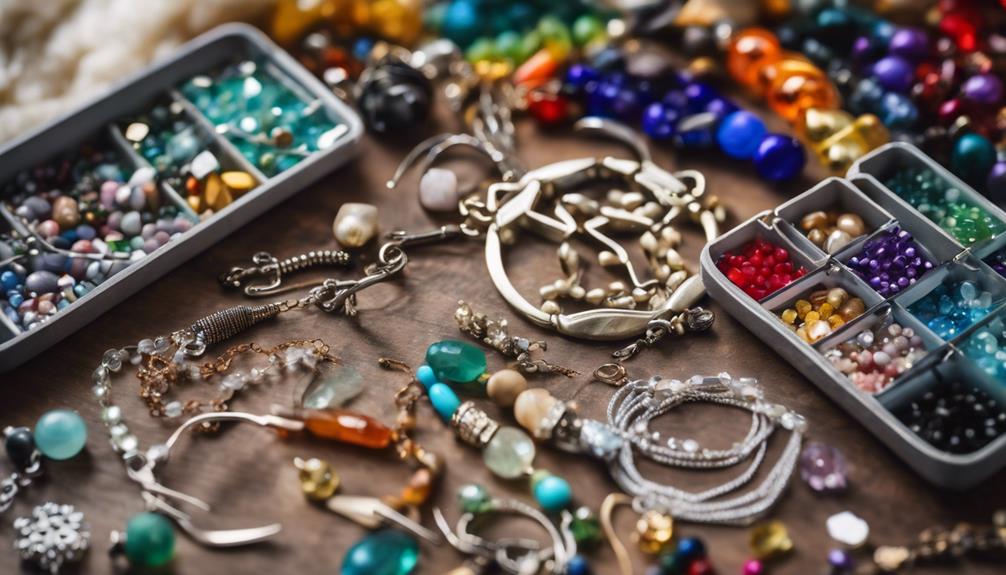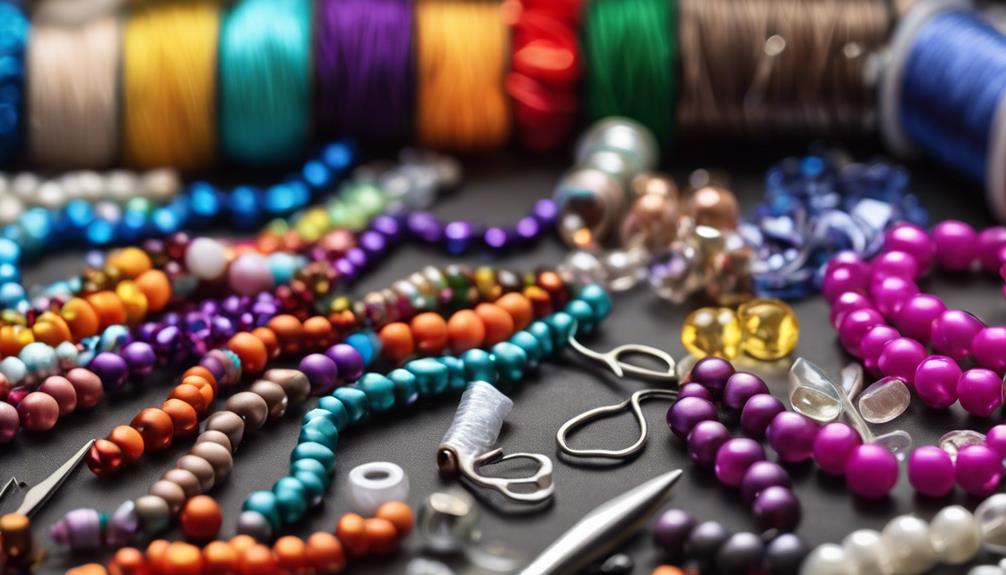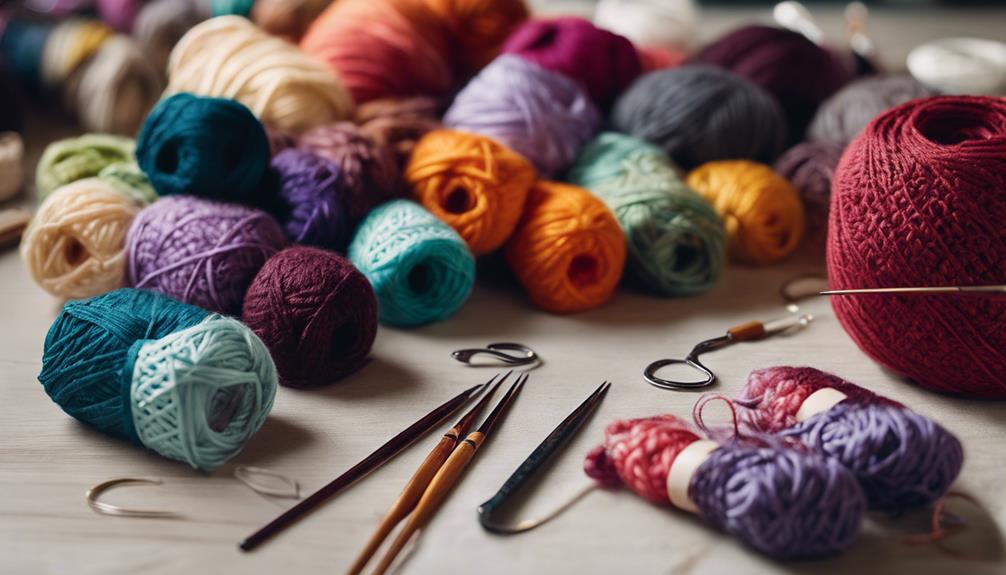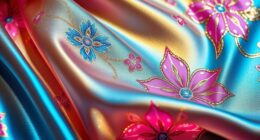If you want precise, reliable color calibration in 2025, I recommend checking out top monitors like those supported by SpyderPro and Calibrite devices. These tools guarantee your displays stay accurate across HDR, OLED, and mini-LED screens, with features tailored for professional workflows. From quick calibration to detailed profile adjustments, the right monitor and calibration tools can dramatically improve your work. Keep exploring further, and you’ll discover how to choose the perfect setup for your needs.
Key Takeaways
- Look for monitors supporting hardware calibration with professional tools like SpyderPro or Calibrite for accurate, consistent colors.
- Ensure the monitor offers advanced calibration features such as white point, gamma control, and profile validation for precise color accuracy.
- Choose displays with high native resolution and wide color gamuts (Rec. 2020, DCI-P3) for crystal-clear, vibrant visuals.
- Opt for monitors with easy-to-use software compatibility across operating systems for streamlined calibration workflows.
- Prioritize models with stable color profiles, adjustable calibration settings, and reliable long-term color fidelity for professional design work.
SpyderPro Monitor Calibration Tool
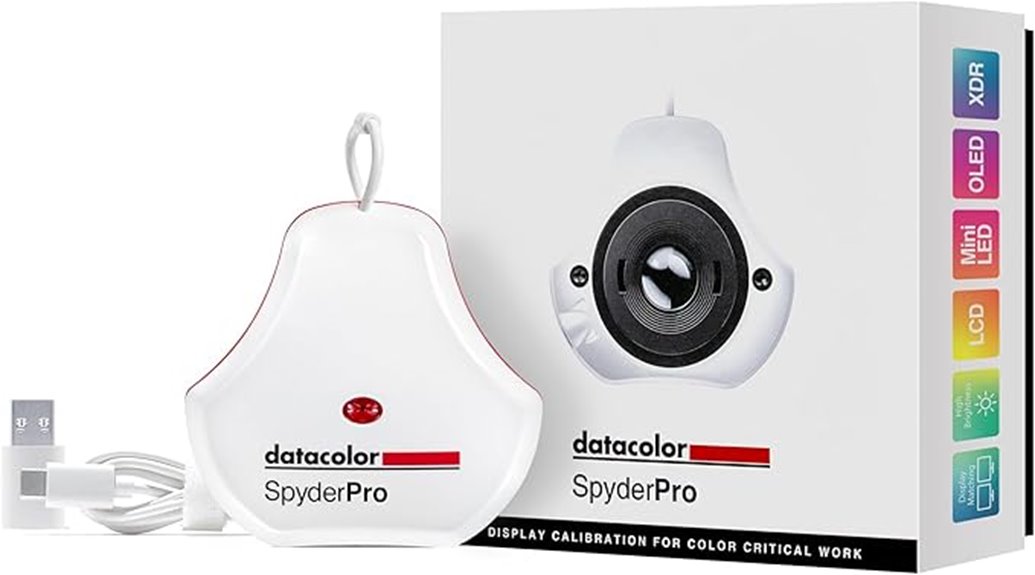
The SpyderPro Monitor Calibration Tool by Datacolor is the perfect choice for designers who need quick, accurate color calibration without sacrificing ease of use. It offers professional-level results in just about 90 seconds, making setup fast and effortless. Whether you’re working with high-brightness, OLED, mini-LED, or Apple Liquid Retina XDR displays, it supports a wide range of modern screens. Its intuitive software includes pre-set options for beginners and customizable settings for pros. Plus, features like StudioMatch ensure consistent colors across multiple monitors, and DevicePreview TM Beta helps visualize how images appear on different devices. It’s a dependable tool for confident, precise color management.
Best For: designers and creative professionals seeking quick, accurate, and professional-level color calibration for various modern display types with easy-to-use features.
Pros:
- Supports a wide range of modern displays including high-brightness, OLED, mini-LED, and Apple Liquid Retina XDR
- Achieves calibration in approximately 90 seconds, ensuring fast setup
- Features like StudioMatch and DevicePreview TM Beta enhance color consistency across multiple devices
Cons:
- May be more expensive than basic calibration tools for casual users
- Advanced features might require some learning for beginners
- Limited information on compatibility with very specialized or older display models
Calibrite Display 123 Colorimeter (CCDIS123)
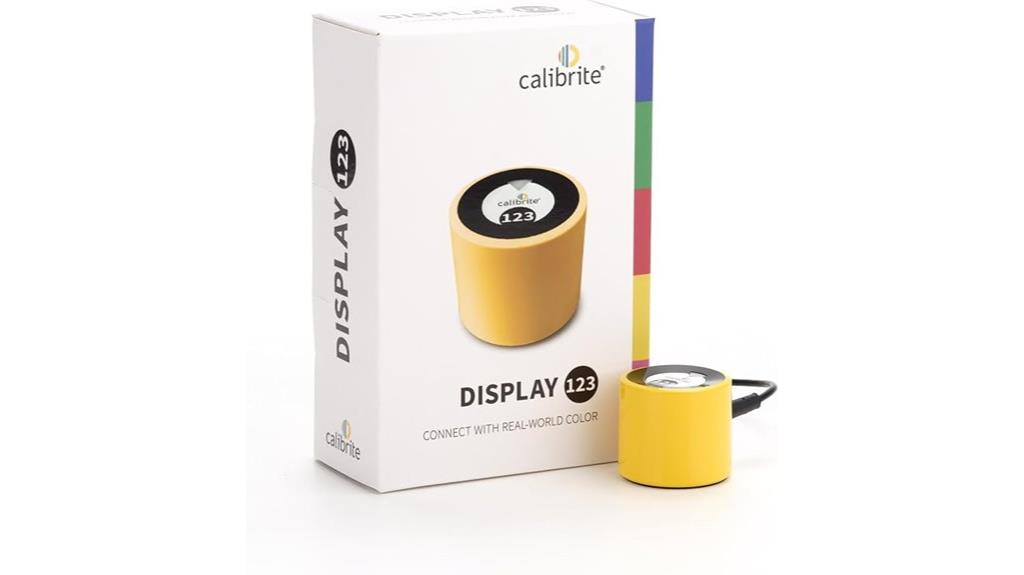
If you’re looking for an easy-to-use color calibration tool that supports multiple displays, the Calibrite Display 123 Colorimeter (CCDIS123) is an excellent choice. It’s designed for quick, accurate calibration of up to two monitors, ensuring consistent and precise colors for editing, gaming, or everyday use. The calibration process is straightforward—just follow the simple steps, and you’re set. You can choose between Native or Photo brightness modes, making it versatile for different tasks. Whether you’re maintaining color accuracy for professional work or home projects, the CCDIS123 helps keep your displays consistent, reliable, and ready for any color-sensitive activity.
Best For: users seeking an easy-to-use, reliable color calibration tool for up to two monitors to ensure color accuracy in editing, gaming, or everyday activities.
Pros:
- Simple calibration process with straightforward steps
- Supports calibration of two displays simultaneously
- Offers versatile brightness modes (Native and Photo) for different tasks
Cons:
- Limited to calibrating only two monitors at once
- May lack advanced calibration features found in professional-grade devices
- Designed primarily for casual and semi-professional use, not high-end color grading
Calibrite Display Pro HL (CCDIS3HL)
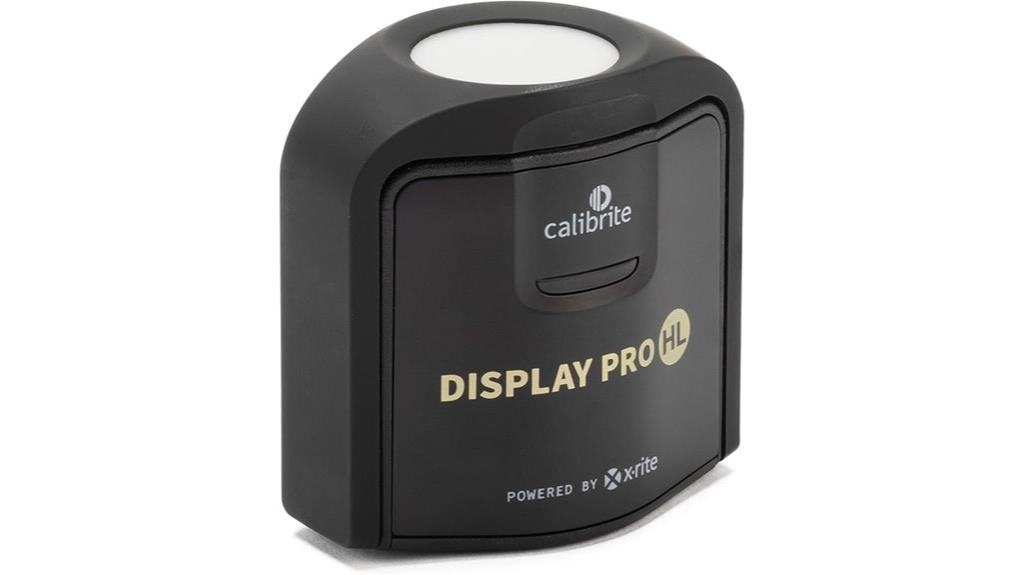
For professionals demanding the highest level of color accuracy, the Calibrite Display Pro HL (CCDIS3HL) stands out with its impressive ability to measure up to 3,000 nits using an advanced HL sensor. This allows it to calibrate high-brightness displays like LCD, mini-LED, and OLED screens, including Apple XDR panels. The device pairs with Calibrite PROFILER software, offering customizable options such as White Point, Gamma, Profile Validation, and Uniformity Check. Its USB-C connection ensures fast setup, and the recyclable packaging and travel pouch make it ideal for on-the-go professionals seeking precise, reliable calibration for current and future display tech.
Best For: professionals who require the highest level of color accuracy and calibration for high-brightness, professional-grade displays such as LCD, mini-LED, and OLED screens, including Apple XDR panels.
Pros:
- Capable of measuring up to 3,000 nits for precise calibration of high-brightness displays
- Compatible with a wide range of display technologies including OLED, mini-LED, and LCDs
- Comes with customizable calibration options via Calibrite PROFILER software for tailored color management
Cons:
- Higher cost may be a barrier for casual or hobbyist users
- Requires USB-C connection, which may necessitate adapters for some devices
- Primarily designed for professional use, potentially overkill for basic display calibration needs
Calibrite ColorChecker Display Pro (CCDIS3)
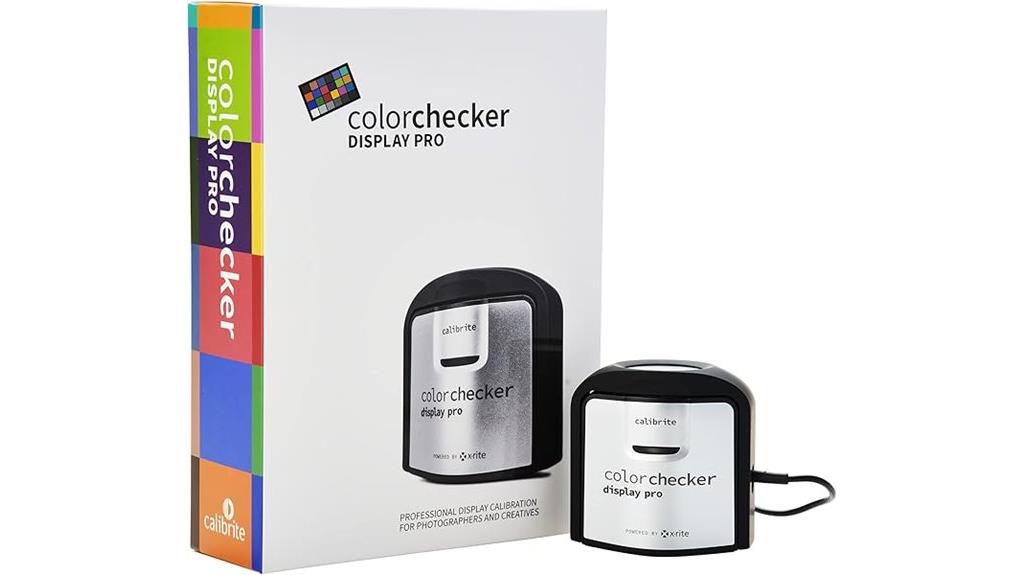
Designed with ease of use and precise color accuracy in mind, the Calibrite ColorChecker Display Pro (CCDIS3) stands out as an excellent choice for professionals who need reliable calibration across various display types. Its optical design guarantees high repeatability and consistent results, whether calibrating monitors or projectors. The device features a rotatable diffuser arm and integrated tripod mount, making it versatile for different workflows. Compatible with ccProfiler, i1Profiler, and third-party software like DisplayCAL, it delivers validated ∆E < 2 accuracy. Users report improved color fidelity, especially in shadows and skin tones, streamlining editing and print matching for photographers and designers alike.
Best For: professionals and enthusiasts seeking precise, reliable display calibration for monitors and projectors across various display technologies.
Pros:
- High accuracy with validated ∆E < 2 for consistent color fidelity
- Versatile design includes diffuser arm and tripod mount for multiple workflows
- Compatible with popular calibration software like ccProfiler, i1Profiler, and third-party tools
Cons:
- Some users report durability issues, such as coating deterioration and hardware failures
- Support response times and after-warranty assistance can be slow or limited
- Struggles with newer display tech like JOLED RGB panels, particularly in reading reds accurately
Handheld Colorimeter, Portable Digital Color Reader and Tester
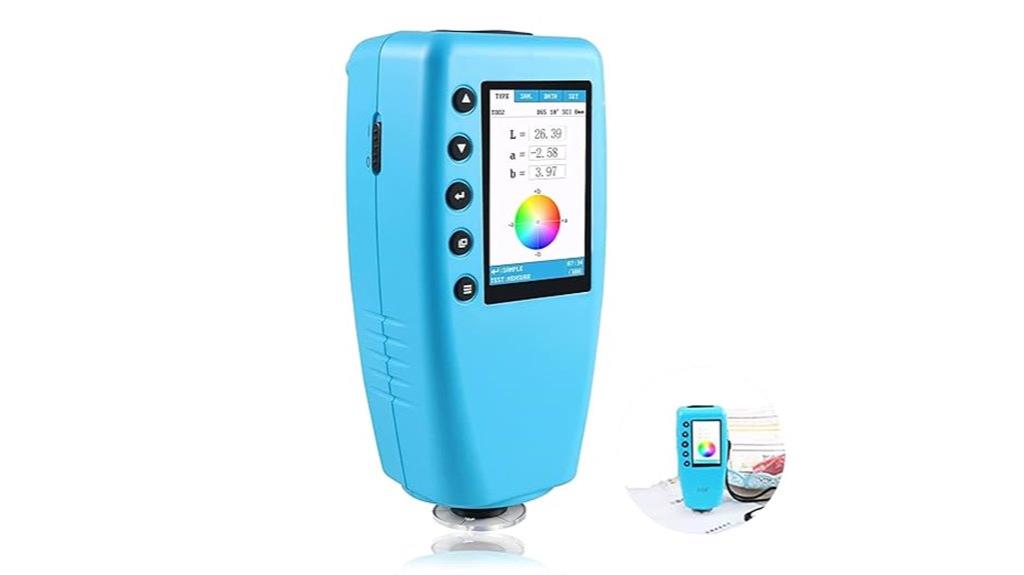
A handheld colorimeter stands out as an essential tool for professionals who need precise, on-the-spot color measurements across various industries. I’ve used these devices for color quality control, testing differences, sampling, and online assessments. With an 8mm aperture and true-color display, they deliver accurate results quickly. They’re perfect for textiles, printing, dyes, plastics, and even food or medicine. Their high precision—accuracy up to 0.01—and stability ensure reliable data. Plus, their portable design, energy-efficient battery, and easy data display make them practical for fieldwork or lab use. They’re invaluable for maintaining consistent color standards in fast-paced production environments.
Best For: professionals in industries like textiles, printing, plastics, and food who require precise, portable, and quick color measurements for quality control and matching.
Pros:
- High accuracy with a measurement precision of up to 0.01 and excellent repeatability
- Portable and user-friendly design with a large true-color display for easy operation
- Supports direct data display and optional printing for convenient documentation
Cons:
- Limited to 8mm aperture, which may not suit very large sample sizes
- Requires optional accessories like a mini-printer for advanced reporting needs
- Performance can be affected if not handled properly, despite the 1-year free replacement policy
Calibrite Creator Kit – Display 123 and Passport Video 2 (CC123-PPV2)
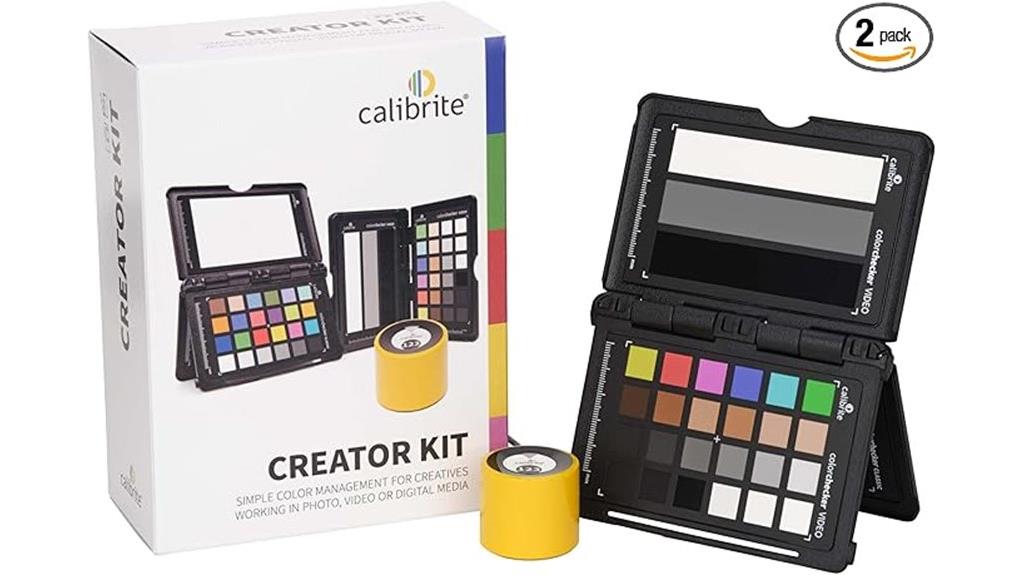
If you’re aiming for pinpoint color accuracy in your creative workflow, the Calibrite Creator Kit—featuring the Display 123 colorimeter and Passport Video 2 calibration targets—is an excellent choice. It offers seamless software for adjusting white points, exposure, and custom profiles tailored for both video and photo work. The Display 123 calibrates up to two monitors via USB-C, ensuring consistent, precise colors across screens. Meanwhile, Passport Video 2 targets help you achieve accurate in-camera white balance and exposure, plus create camera profiles for raw images. This kit provides professional-grade control, making it easier to maintain color fidelity in any lighting or camera setup.
Best For: creative professionals seeking accurate color calibration and profiling tools for both video and photo workflows to ensure consistency across devices and lighting conditions.
Pros:
- Provides comprehensive control with intuitive software for white point, exposure, and custom profile adjustments
- Calibrates up to two monitors via USB-C for consistent color accuracy across multiple screens
- Includes targets for precise in-camera white balance, exposure, and raw image profiling
Cons:
- Limited to calibration of up to two monitors, which may not suffice for larger setups
- Requires a 12V battery, adding an extra step for power setup
- The dimensions and weight suggest a compact design, but portability for travel may be limited depending on user needs
Colorimeter, Precision Colorimeter NR200 for Painters and Graphic Designers
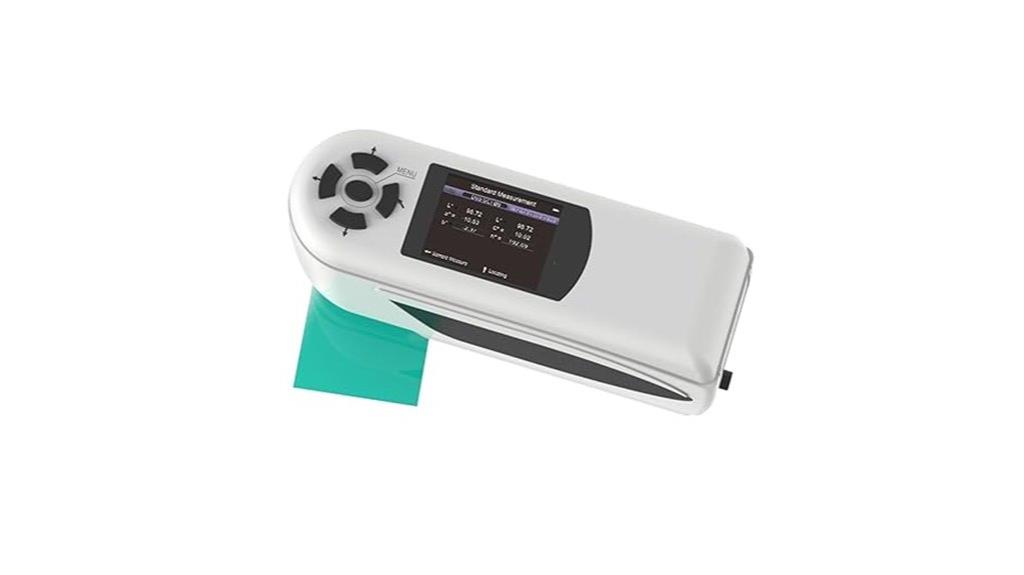
For painters and graphic designers seeking precise color matching, the Precision Colorimeter NR200 stands out with its advanced technology and user-friendly features. It offers stable, accurate measurements with a repeatability error of just 0.08 and minimal equipment error at 0.50E*ab. Its ergonomic design, lightweight build, and one-touch operation make it easy to use in various environments. Capable of storing up to 100 standards and 20,000 samples, it performs over 3,000 measurements per charge thanks to a high-capacity battery. With software for detailed color analysis and data management, the NR200 guarantees consistent, reliable color calibration for professional artistic and industrial applications.
Best For: painters and graphic designers seeking precise, stable color measurement and calibration for professional artistic and industrial applications.
Pros:
- Highly accurate with a repeatability error of just 0.08 and minimal equipment error of 0.50E*ab
- User-friendly ergonomic design with lightweight portability for easy operation in various environments
- Capable of storing extensive data (up to 100 standards and 20,000 samples) and performing over 3,000 measurements per charge
Cons:
- Initial charging requires 8 hours, which may delay first use
- Limited details on compatibility with other color management systems or software integrations
- Slightly higher cost compared to basic colorimeters, potentially impacting budget-conscious users
Calibrite Display SL (CCDISSL)
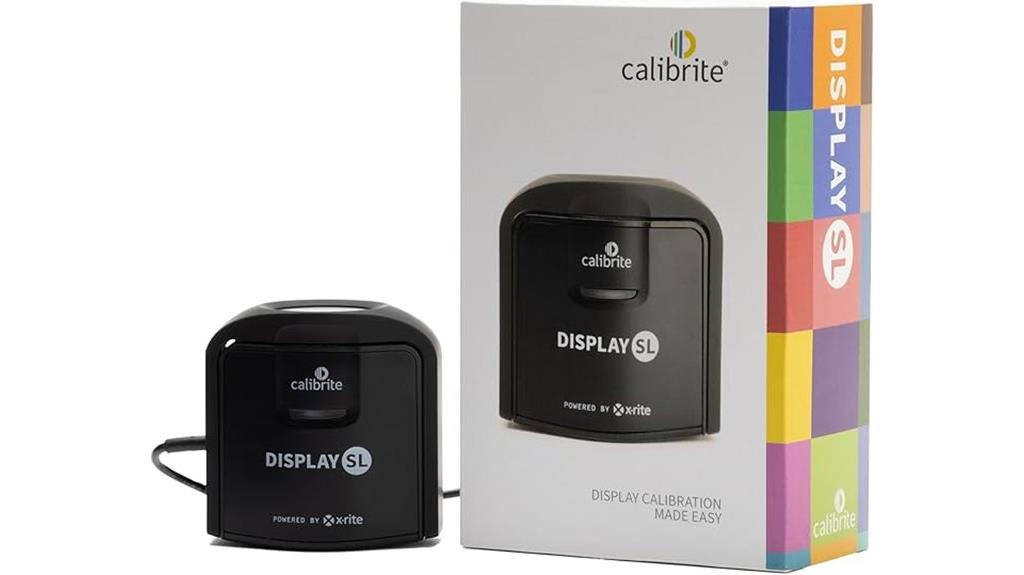
The Calibrite Display SL (CCDISSL) stands out as a top choice for professionals seeking precise color calibration on LCD displays. This advanced SL sensor is tailored for still image and video editing, offering industry-standard accuracy. Its USB-C connection, along with a USB-A adapter, makes it versatile for multiple displays. The included Calibrite PROFILER software is intuitive and compatible with both Mac and Windows, ensuring consistent, accurate colors. Compact and lightweight, it’s easy to carry on the go, and its recyclable packaging adds eco-friendliness. Reliable and user-friendly, the CCDISSL is a solid tool for achieving professional-grade calibration anywhere.
Best For: professionals and enthusiasts who need precise color calibration for LCD displays during still image and video editing.
Pros:
- Offers industry-standard luminance accuracy for professional editing.
- Compatible with both Mac and Windows via Calibrite PROFILER software.
- Compact, lightweight, and portable with eco-friendly packaging.
Cons:
- Requires a 12V battery for operation, adding to setup considerations.
- Customer rating is moderate at 3.9 out of 5 stars based on reviews.
- Limited to LCD display calibration, not suitable for other display types.
Factors to Consider When Choosing Colour Calibrated Monitors for Designers
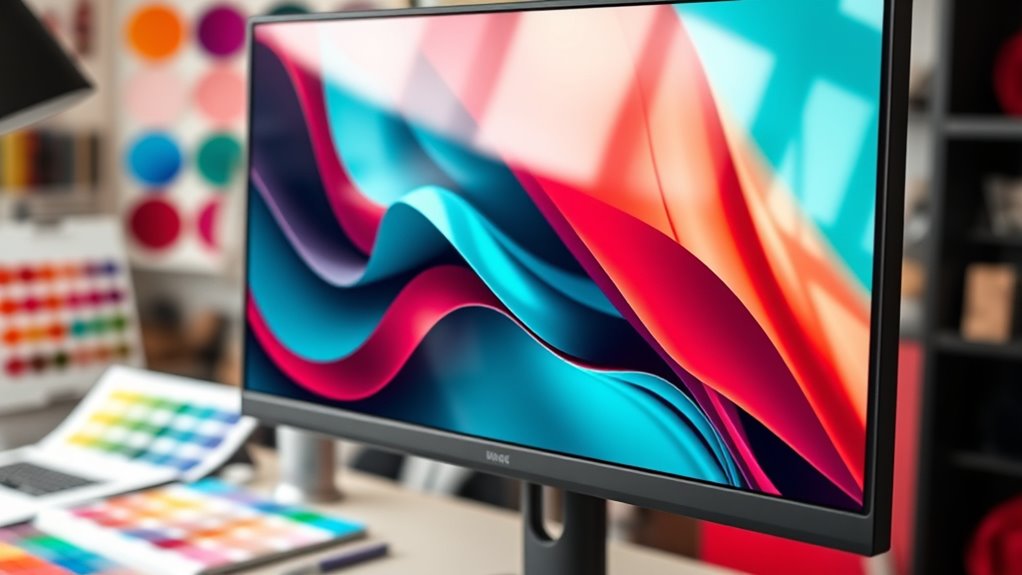
When choosing a color-calibrated monitor, I focus on key factors like color accuracy and the range of colors it can display, ensuring my work looks precise. I also consider how easy and quick it is to calibrate the monitor, along with compatibility with my existing software and hardware. Ultimately, I look for consistent color performance across devices and useful features that support my workflow.
Color Accuracy and Gamut Range
Have you ever wondered how accurately a monitor can reproduce colors? It all comes down to its color accuracy, often measured by the ∆E value—lower values mean more precise color matching, which is essential for professional design. Equally important is the monitor’s color gamut coverage, like sRGB, Adobe RGB, or DCI-P3, which dictates the range of colors it can display. A high-quality calibrated monitor typically supports over 99% of industry standards, ensuring vibrant, true-to-life visuals. Consistent calibration helps maintain this accuracy over time, indispensable for collaborative projects and client work. Monitors with advanced color management features, including broad gamut support, give designers reliable, precise color reproduction, making sure what you see on screen is exactly what you get in print or digital formats.
Calibration Ease and Speed
Achieving accurate color reproduction quickly is essential for designers working on tight deadlines. Monitors with fast calibration processes—around 90 seconds—help minimize downtime and keep projects on track. User-friendly software interfaces that guide step-by-step adjustments make calibration straightforward, even for beginners. Automated or pre-set calibration options further streamline the process, ensuring consistent results and saving time during routine updates. Compatibility with advanced calibration tools that support high-end display technologies like OLED or mini-LED speeds up profiling, especially for premium screens. Additionally, features like StudioMatch allow for quick calibration across multiple monitors simultaneously, reducing workflow disruptions. Overall, a monitor with easy, fast calibration capabilities means less hassle and more focus on creating great designs.
Display Technology Compatibility
Choosing a monitor with the right display technology is essential for guaranteeing accurate color calibration. Different panel types like OLED, mini-LED, or LCD have unique characteristics that can affect calibration accuracy. I recommend verifying that your calibration tools support these specific technologies, especially for high-end displays like Apple Liquid Retina XDR or OLED screens with high brightness. It’s also imperative to ensure your calibration device can read and profile these panels accurately to maintain color fidelity. Additionally, check if the monitor’s color space support, such as Rec. 709 or Rec. 2020, aligns with your calibration hardware. Compatibility between calibration software, hardware, and display technology is crucial to avoid inaccurate readings or failed calibrations, ensuring your monitor delivers precise, consistent colors for professional work.
Color Consistency Across Devices
Ensuring consistent color across multiple monitors is essential for professional designers, as even slight discrepancies can compromise the integrity of your work. Achieving this requires precise calibration to match color profiles and gamma settings across devices. Using hardware calibration tools helps maintain accuracy over time, preventing color drift caused by display aging or environmental factors. Regular calibration and profile updates are crucial, especially when working with print, video, or digital media, to ensure visual uniformity. Compatibility with industry-standard color spaces like Rec. 709 and Rec. 2020 further enhances consistency, making sure colors look the same across different devices. When selecting a monitor, prioritize those that support accurate calibration, stable color profiles, and reliable hardware adjustment options to maintain perfect color harmony in your workflow.
Software Features and Support
Have you checked if the calibration software for a monitor works smoothly with your operating system? Compatibility is vital to avoid glitches and ensure seamless calibration. Look for tools with advanced features like white point adjustment, gamma control, and profile validation—these help achieve precise color management. Real-time monitoring and adjustable presets can streamline your workflow and adapt to changing lighting conditions effortlessly. It’s also important that the software supports industry-standard color spaces such as Rec. 709, Rec. 2020, or DCI-P3, aligning with your specific design or video needs. Additionally, verify that the calibration software receives regular updates and offers reliable technical support. These factors guarantee your monitor remains accurate, compatible, and easy to maintain over time, ultimately enhancing your creative process.
Budget and Value Considerations
Budget constraints can markedly influence the selection of color-calibrated monitors, especially for designers who need reliable accuracy without overspending. Entry-level monitors with basic calibration tools can still notably improve color precision, making them suitable for those on a tighter budget. However, higher-end monitors often require professional calibration devices that support advanced features like HDR and wide color gamuts, justifying their higher costs. Keep in mind that budget-friendly calibration solutions might have limited support for newer display technologies such as OLED or mini-LED, which could impact long-term value. Investing in a reliable calibration device can save time and resources by ensuring consistent color accuracy across multiple projects and displays. Balancing initial costs with ongoing calibration needs is key to maximizing overall value.
Frequently Asked Questions
How Do Color Calibration Tools Impact Workflow Efficiency?
Color calibration tools profoundly boost my workflow efficiency by ensuring consistent, accurate colors across all projects. When my monitor is properly calibrated, I spend less time tweaking colors and correcting mismatches later. It streamlines my process, reduces mistakes, and speeds up my work. With reliable color accuracy upfront, I can focus more on creativity and less on troubleshooting, making my entire design process smoother and more productive.
Are Calibration Devices Compatible With All Operating Systems?
Calibration devices are generally compatible with most operating systems, acting like a universal translator for your display. I’ve found that many brands support Windows, macOS, and sometimes Linux, ensuring smooth integration across platforms. However, it’s wise to double-check each device’s specifications before purchasing. Think of it as ensuring all your tools speak the same language, so your workflow stays seamless and your colors stay true.
How Often Should Professional Designers Recalibrate Their Monitors?
I recommend recalibrating your monitor at least once a month to guarantee colors stay accurate, especially if you’re working on critical design projects. If you notice color shifts or your workspace environment changes considerably, recalibrate sooner. Regular calibration helps maintain consistency across your work, saving you time and frustration. Trust me, keeping your monitor calibrated ensures your designs look perfect every time, no matter the project.
Can Calibration Tools Improve Color Consistency Across Multiple Screens?
Yes, calibration tools can definitely improve color consistency across multiple screens. I use calibration devices to guarantee each monitor displays accurate, matching colors, which is essential for my work. By regularly calibrating, I avoid discrepancies that can cause my designs to look different on various screens. It’s a simple step that makes a big difference in maintaining uniformity and professional quality across all my displays.
What Is the Best Way to Verify Calibration Accuracy After Setup?
Did you know that nearly 30% of designers report color mismatches after calibration? To verify calibration accuracy, I recommend using a hardware calibration report and a dedicated colorimeter to spot-check key colors. Viewing test images with known color values on your monitor helps confirm consistency. Regularly recheck your calibration, especially after system updates or ambient light changes, to keep your display true to color.
Conclusion
Choosing the right colour-calibrated monitor is like finding a reliable compass in a sea of options. It guarantees your designs are true to life, saving you time and frustration. Whether you’re a photographer, graphic designer, or painter, investing in a quality calibration tool ensures accurate colors and crisp visuals. Remember, the perfect monitor is out there — it’s just a matter of finding one that aligns with your creative needs.

